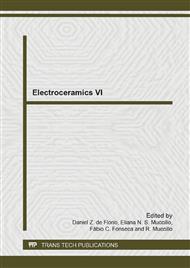p.189
p.194
p.201
p.207
p.213
p.219
p.224
p.233
p.238
Photocatalytic Decomposition of Rhodamine-B Using Scandium and Silver-Modified TiO2 Powders
Abstract:
Semiconductor-mediated photocatalytic oxidation is an interesting method for water decontamination and a specially modified TiO2 is said to be a promising material. This study verified that the synthesis of 1wt%Ag modified-Sc0.01Ti0.99O1.995 powder samples prepared by Polymeric Precursor Method is capable of forming a mixture of anatase-rutile phase with high photocatalytic performance. This kind of material is found to have a lower bandgap compared to the TiO2-anatase commercial powders, which can be associated to an innovative hybrid modification. The simultaneous insertion of scandium in order to generate a p-type semiconductor and a metallic silver nanophase acting as an electron trapper demonstrated being capable of enhancing the degradation of rhodamine B compared to the commercial TiO2. In spite of the different thermal treatments or phase amounts, the hybrid modified powder samples showed higher photocatalytic activity than the commercial ones.
Info:
Periodical:
Pages:
213-218
Citation:
Online since:
July 2014
Keywords:
Price:
Сopyright:
© 2014 Trans Tech Publications Ltd. All Rights Reserved
Share:
Citation:


